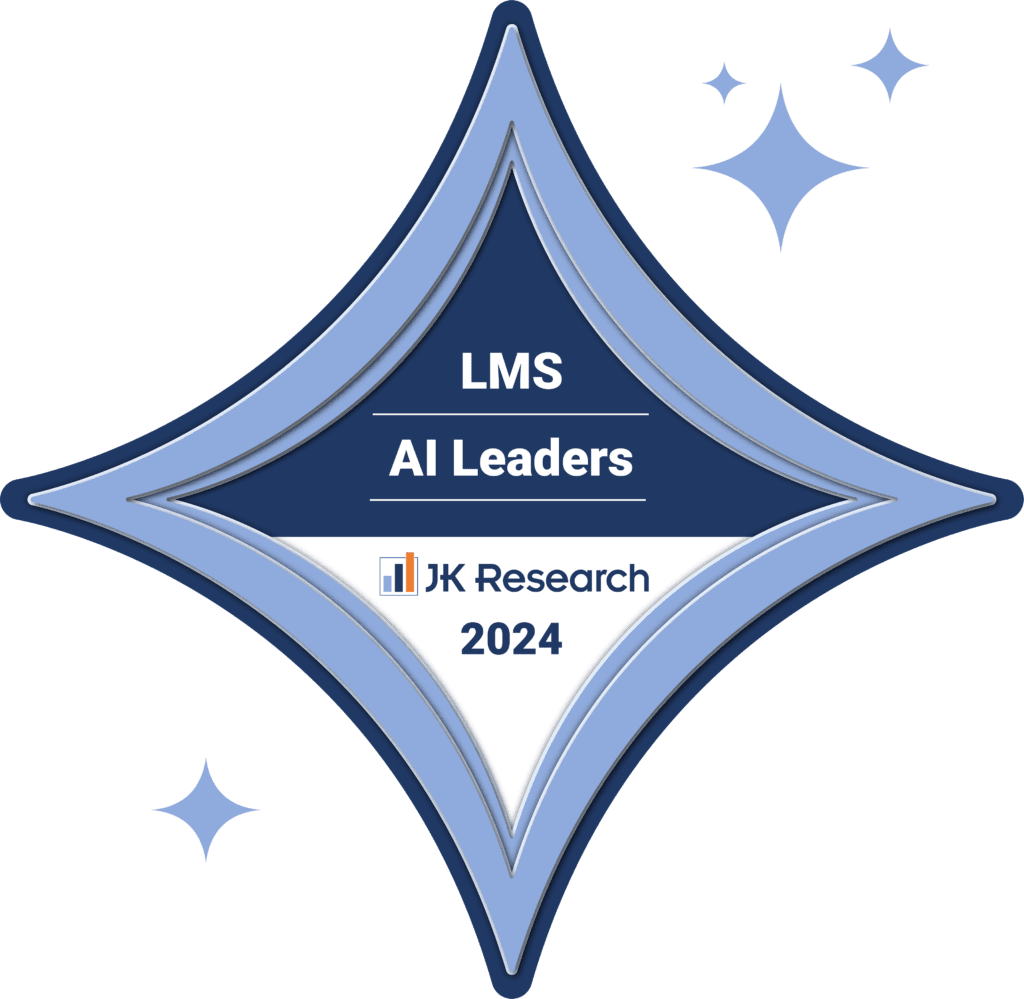The success of any product is determined by its user adoption.
This is just as true of the latest iPhone as it is an LMS.
An excellent, intuitive, valuable product, one that’s born of market necessity or innovation, can flounder if people don’t use it.
Now market expectations vary tremendously. Products like the latest generation iPhone demand constant innovation year on year. LMSs aren’t under that amount of pressure. They don’t need to evolve repeatedly in a short space of time.
What LMSs should do is leverage technology to empower L&D teams to accelerate their learning culture, talent acquisition, leadership development, and internal mobility.
To achieve this an LMS must employ 11 core strategies.
This is especially important when organisations begin to forecast for the year ahead.
Below is a list of 11 LMS strategies that your organisation should be leveraging to improve learner engagement as we move into 2025. 👇
1. Create a user-centric design
An LMS should have a user-centric design. If nothing else, a user-centric design promotes better learner engagement.
But more than that, it should be simple to use and require minimal effort.
Users should be able to access content with as few clicks as possible. The easier the LMS is to navigate, the more they’ll engage with the platform.
Consider the layout carefully. Think about the content structure. Add relevant resources. Clearly highlight navigation. Ensure that the UX is logical.
Then there’s the brand.
Have a strong brand identity. One that users can recognise instantly. Reinforce this with clear consistent messaging. Foster familiarity. Promote trust and authority. Showcase how easy it is to use.
All this promotes value. And reinforces why organisations should invest in LMS software. 🙌
2. Focus on functionality and adaptability
Effective LMSs are those that can improve core business systems, whilst having an infrastructure capable of adapting and evolving with your business.
Remember L&D evolves over time. You need a LMS that is geared for a new era of L&D.
This is precisely what Thirst offers.
Thirst empowers organisations to close the skills gaps faster by using machine learning to identify the skills, interests, and engaging content to elevate the organisation’s upskilling and reskilling whilst cultivating a unique learning experience. 👍👍
This allows organisations to easily scale their own operations, build a culture of collaboration, leverage dashboard insights to identify knowledge and skills bottlenecks, and continuously improve organisational L&D processes.
3. Empower people to develop their own skills
An LMS is only as good as its ability to develop the skills of your workforce. And LMSs can help your organisation to cultivate a strong learning environment, complete with a straightforward journey that puts people on the pathway to personal and professional growth.
Put the power in the hands of people. Gain insights into the organisation as a whole. Identify skills shortages. Upskill people so that your organisation can deliver stellar customer service.
Revolutionise your L&D with interactive and immersive learning.
Blend digital and peer-to-peer learning and promote a continuous learning ethos.
4. Data-driven learning pathways
Machine learning can provide data-driven insights to tap into LMS data.
This data can then be extrapolated to better understand employee performance and provide a broad range of insights into the organisation’s L&D efforts.
Take advantage of predictive analytics and machine learning to forecast future skill requirements and develop tailored L&D programs based on performance data and commercial objectives. 💰💰
Better still, predictive analytics can be employed to measure the effectiveness of L&D content, the ways that it can be improved, whilst identifying learning patterns and techniques among employees and mapping trends. 📈
The results of this? More informed decisions can be made about learning content, even teaching methods.
5. Automation and AI
Incorporate AI into your L&D strategy and modernise professional development.
AI gives L&D leaders the ability to address skills gaps, boost productivity, and leverage an agile workforce to remain competitive in an evolving landscape. 😀
From creating personalised learning paths and tailored content resources to encouraging continuous learning, even leveraging robust data collection and analysis to feed AI algorithms whilst simultaneously monitoring and refining AI-powered solutions, incorporating automation and AI into your L&D strategy will drastically improve its effectiveness.
6. Personalised learning experiences
We all learn differently. Some people are visual learners. Others auditory learners. Some of us prefer reading and writing exercises, other a kinaesthetic approach.
This means that successful L&D strategies must cater to different types of learners by personalising learning experiences. Allowing learners to customise their LMS interface gives them a greater sense of ownership.
A dashboard that displays information relevant to individual learners will also increase engagement. 🤔
For instance, providing learners with an overview screen which details any L&D courses they need to complete, would benefit from, or can sign up to, is a great way to improve usability and overall learning experience.
7. Promote mobile learning
For L&D to be successful in the workplace it must be flexible. Learners expect to complete any training at a time that’s convenient to them, on a device of their choice.
Therefore, organisations must optimise their L&D content for mobile devices. Focus on user experience. Ensure that any resource load times don’t lag, and buttons are strategically scattered throughout the design. 📲💻
8. Social learning features
Corporate LMS should always use interactive or online features, such as social media feeds and gamification. Why? L&D that encourages collaboration, communication, and shared experiences is more memorable.
Incorporate polls, newsfeeds, even leaderboards, and comment sections and you’ll create an engaging learning experience, one that promotes interaction and retention.
Better still, a gamified LMS infrastructure connects online training, activities, courses, and modules.
You could even transform the whole experience into something that’s fun and rewarding, with a few prizes to boot! 🏆
9. Build a community of learners
Communities are more important than you may think to the L&D experience. Why? Social media platforms like Facebook, X, LinkedIn, and Instagram have created an entire generation of people used to getting their dopamine from online communities.
Communities can motivate learners. They can offer encouragement and rewards. And celebrate achievements together. 🥳
This collective ethos translates perfectly to L&D. What better way to get everyone enthused by learning than having everyone participate in the experience together!
Moreover, building a learning community is especially important in today’s hybrid and remote working models. It’s common for colleagues to feel disconnected, and any opportunity to bring people together is nothing but positive.
10. Provide continuous feedback
In the workplace, everyone wants to know how they’re performing and what happens if they don’t perform to the standard set.
Now, of course, people are a little more complex than that, however, when all’s said and done, strong performance equals job retention, promotion, and career success.
An organisation with a strong focus on L&D strategies knows that providing continuous feedback fosters loyalty, ambition, and camaraderie.
It encourages people to develop new skills and helps organisations to remain competitive in an evolving commercial environment. 💸💸
11. Compliance and certification tracking
L&D leaders often face scrutiny to demonstrate the impact of their learning initiatives. This means that reporting L&D compliance rates is paramount.
So, in a nutshell, if you have one hundred employees and eighty of them have completed the required health and safety training, you have a compliance rate of 80%.
This demonstrates that 80% of your employees are aware of, and have the necessary knowledge and skills, to perform their role safely.
Implementing compliance and certification tracking into your LMS infrastructure means that you can identify which employees need upskilling.
This enables you to create a transparent L&D plan for all to see and makes compliance and certification tracking much easier.
Make 2025 the year you improve your Learning Management System
Without a rigid LMS in place, how are you ever going to optimise and improve learner engagement if you don’t have a learning management system that gives your people the foundation and infrastructure they need to excel?
Unsure what to do next?
Get in touch with Thirst today, and you’ll be able to leverage pioneering LMS power to ensure that your organisation can leverage core strategies to build on existing success and achieve great things in the year ahead.
Our AI-powered learning platform empowers L&D professionals to accelerate their learning culture, talent acquisition, leadership and development, and internal mobility. 🙌
Get in touch with Thirst and book a demo today.
For more e-learning insights, resources and information, discover the Thirst blog.
You may also enjoy:
Learning Loops: How to Use Them to Drive Learner Engagement | LXP vs. LMS: What’s the Difference? | Learner Engagement: What It Is and Tips to Improve It







